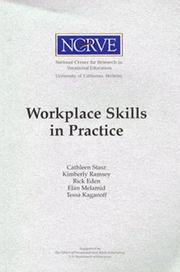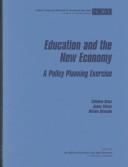| Listing 1 - 10 of 19 | << page >> |
Sort by
|

ISBN: 0833023683 Year: 1996 Publisher: Santa Monica, CA : RAND,
Abstract | Keywords | Export | Availability | Bookmark
 Loading...
Loading...Choose an application
- Reference Manager
- EndNote
- RefWorks (Direct export to RefWorks)
Employees --- Vocational education. --- Personnel --- Enseignement professionnel --- Training of. --- Formation
Book
Year: 1993 Publisher: Santa Monica, CA : RAND,
Abstract | Keywords | Export | Availability | Bookmark
 Loading...
Loading...Choose an application
- Reference Manager
- EndNote
- RefWorks (Direct export to RefWorks)
This study examined how generic skills and work-related attitudes can be taught in academic and vocational high school classrooms. An instructional model for these skills and attitudes was identified that included instructional goals, classroom design, teaching techniques, and school context. Generic skills and work-related attitudes can be taught in both academic and vocational classrooms. Instructional goals should include a mix of generic and domain-specific skills. Classroom design should incorporate structural and cultural aspects of workplaces, and learning should be situated in complex, "authentic" projects that resemble adult work. Situated learning should be supported through non-authoritarian teacher roles and teaching techniques. Student assessment should emphasize the learning of generic skills and attitudes. To implement this instructional model, teachers need autonomy as well as appropriate teacher training and staff development.
Education, Secondary --- Critical thinking --- Occupational training --- Life skills --- Basic education --- Case studies. --- Study and teaching (Secondary)
Book
Year: 1990 Publisher: Santa Monica, CA : RAND Corporation,
Abstract | Keywords | Export | Availability | Bookmark
 Loading...
Loading...Choose an application
- Reference Manager
- EndNote
- RefWorks (Direct export to RefWorks)
Vocational education --- Critical thinking --- Occupational training --- Life skills --- Basic education --- Study and teaching
Book
Year: 1996 Publisher: Santa Monica, CA : RAND Corporation,
Abstract | Keywords | Export | Availability | Bookmark
 Loading...
Loading...Choose an application
- Reference Manager
- EndNote
- RefWorks (Direct export to RefWorks)
Many believe that the workplace has changed in ways that require workers with higher and more varied skills--and that schools are not producing students with such skills. In this study, the authors sought to better understand skills required in technical work, the institutional context in which work takes place, and employers' strategies for meeting perceived skill requirements. The study used a sociocultural approach to examine skills and work-related dispositions (tendencies to use one's capabilities on the job) in four diverse industries. A rich picture emerged, demonstrating that work context matters in the consideration of skills: workplaces are complex, dynamic social systems that defy simplistic categorization of skills and straightforward matching of skill requirements to jobs. The study also found that employers do not necessarily understand the skills required, especially for frontline workers, nor adopt effective strategies for identifying and developing those skills. For example, employers have few connections to education providers and do not fully utilize industry skill certification. These and other findings raise questions about current public policy on school reform and skill standards.
Employees --- Vocational education. --- Skilled labor --- Occupational training --- Labor supply --- Training of. --- Education (Secondary) --- Attitudes.
Book
Year: 1992 Publisher: Santa Monica, CA : RAND Corporation,
Abstract | Keywords | Export | Availability | Bookmark
 Loading...
Loading...Choose an application
- Reference Manager
- EndNote
- RefWorks (Direct export to RefWorks)
Reports the results of a study that compared three urban comprehensive senior high schools to better understand the rationale and processes that underlie schools' course offerings and students' coursetaking. All three schools made assumptions about their students that were related, in large part, to students' race and family socioeconomic status. An analysis of transcripts showed that low-income and disadvantaged minority students took more vocational courses, and that heavy vocational education participation was partially consistent with respondents' beliefs that such a program is best suited for students who are not expected to be successful in academic programs. Vocational programs are perceived negatively within the schools and are unlikely to receive school-level support or staff-development resources. The study recommends that schools press forward with experimentation and the evaluation of possibilities relating to a "strong" version of integrated academic and vocational education.
Track system (Education) --- High schools --- Ability grouping in education --- Vocational education --- Discrimination in education --- Curricula
Book
Year: 1994 Publisher: Santa Monica, CA : RAND Corporation,
Abstract | Keywords | Export | Availability | Bookmark
 Loading...
Loading...Choose an application
- Reference Manager
- EndNote
- RefWorks (Direct export to RefWorks)
The Carl D. Perkins Vocational and Applied Technology Education Act of 1990 required states to develop outcome-based accountability systems built around statewide performance measures and standards. States were given considerable flexibility in selecting outcomes to be measured, the measurement tools, and the standards; their systems were to be in place by the fall of 1992. To assess the progress states have made in the first three years, the authors examined the programs in four states that were among the first to begin implementation. Substantial progress has been made in implementing the measures and standards in these states, although there is wide variation in how they are being implemented. However, as of 1994, little attention had been paid to translating the resulting data into program improvements. Thus, much work remains before the programs function as the lawmakers envisioned. The authors identify a number of factors that reduce the likelihood of state programs functioning as federal lawmakers envision, and the authors suggest specific steps state and federal policymakers should take to improve implementation, including better coordination among accountability requirements in federal and state education and training initiatives.
Vocational education --- Educational tests and measurements --- Education and state --- Standards --- Evaluation --- Case studies.
Book
Year: 1997 Publisher: Santa Monica, CA : RAND Corporation,
Abstract | Keywords | Export | Availability | Bookmark
 Loading...
Loading...Choose an application
- Reference Manager
- EndNote
- RefWorks (Direct export to RefWorks)
This volume covers a study of the utility of alternative (i.e., non-multiple choice) forms of student assessment for vocational education, the primary objective of which was to describe various alternative assessments currently available and offer criteria for choosing among them. Six operational programs were used as case studies; each employs one or more constructed-response measures, and together they represent a range of assessment options. Each was critically reviewed based on descriptive materials, research literature, interviews, and, in four cases, site visits. The evaluation focused on comparing the different assessments' quality (reliability, validity, fairness), feasibility (cost, time, complexity, credibility), and potential usefulness for vocational educators. Design and implementation issues important to any decisions about using alternative assessments were determined (e.g., the need to clarify the assessment's purpose), as well as related issues (e.g., the relative advantages of low versus high stakes, voluntary versus mandatory participation). Illustrations are given of how vocational educators can use this review as an aid in determining the usefulness of the alternatives for a particular situation.
Vocational evaluation --- Educational tests and measurements --- Planning --- Case studies. --- Evaluation
Book
Year: 1993 Publisher: Santa Monica, CA: Rand,
Abstract | Keywords | Export | Availability | Bookmark
 Loading...
Loading...Choose an application
- Reference Manager
- EndNote
- RefWorks (Direct export to RefWorks)
Education, Secondary --- Vocational education --- Educational innovations --- Curricula


ISBN: 0585363064 9780585363066 0833025899 9780833025890 Year: 1998 Publisher: Santa Monica, CA : RAND,
Abstract | Keywords | Export | Availability | Bookmark
 Loading...
Loading...Choose an application
- Reference Manager
- EndNote
- RefWorks (Direct export to RefWorks)
Education --- Economic development --- Education and state --- Federal aid to education --- Vocational education --- Social Sciences --- Education, Special Topics --- Children --- Education, Primitive --- Education of children --- Human resource development --- Instruction --- Pedagogy --- Schooling --- Students --- Youth --- Civilization --- Learning and scholarship --- Mental discipline --- Schools --- Teaching --- Training --- Federal grants for education --- Development, Economic --- Economic growth --- Growth, Economic --- Economic policy --- Economics --- Statics and dynamics (Social sciences) --- Development economics --- Resource curse --- Economic aspects --- Effect of education on --- Standards --- Congresses --- Federal aid --- Law and legislation --- Finance
Book
Year: 1991 Publisher: Santa Monica, CA : RAND Corporation,
Abstract | Keywords | Export | Availability | Bookmark
 Loading...
Loading...Choose an application
- Reference Manager
- EndNote
- RefWorks (Direct export to RefWorks)
This report examines the strategies that education and training institutions in eight communities (Fresno and San Jose, California; Jacksonville and Miami, Florida; Des Moines and Sioux City, Iowa; and Philadelphia and Scranton, Pennsylvania) use to prepare individuals for employment and the ways in which those institutions respond to the federal and state policies they must implement. The authors argue that the effectiveness of individual institutions and programs cannot be assessed without taking into account the entire education and training system operating in the community. The findings indicate that not only do these institutions show substantial regularities in their interactions, but also that in some communities at least, they are quite interdependent, with a clear division of labor. Given this situation, it is difficult to understand how a particular community college, welfare-to-work program, or state economic development initiative operates unless one understands the entire array of institutions providing work-related education and training in a given community.
Vocational education --- Occupational training --- Area vocational-technical centers
| Listing 1 - 10 of 19 | << page >> |
Sort by
|

 Search
Search Feedback
Feedback About UniCat
About UniCat  Help
Help News
News